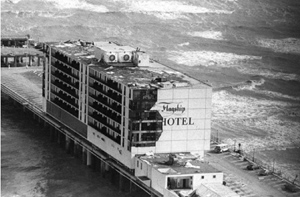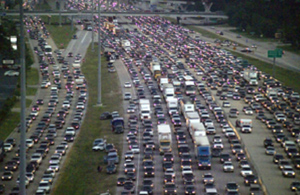Posted on Oct 2, 2022 in
FORT BEND STRONG

I moved to Texas as an excited nine-year-old in July of 1972. We bought a brand-new home in Seabrook, because the public schools in Clear Creek Independent School District were very strong, and my dad had a relatively easy commute on Red Bluff Road to his paper mill in Pasadena. I learned the Gulf hurricane season started on June 1st and ended November 30th. I did not really care that we had just moved into “Hurricane Alley.” An occasional big storm was a small inconvenience compared to the excitement of going to school with classmates whose fathers had walked on the moon. One of my most cherished memories is standing on the sidelines of a soccer game cheering with Fred Haise. Fred was one of the heroes who brought the crippled Apollo 13 rocket home after they encountered an explosion heading to the moon. Texas was cool!
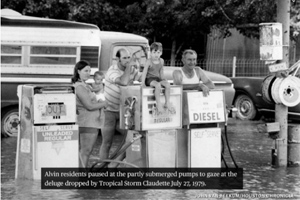
Alvin residents paused at the partly submerged pumps to gaze at the deluge dropped by Tropical Storm Claudette, July 27, 1979.
Photo source: John Van Beekum/Houston Chronicle.
In school, we studied the Galveston Hurricane of 1900. No one knows how many people died when a Category 4 hurricane came roaring ashore with no warning on September 8th, 1900. The death toll was estimated to be as high as 12,000. Our fellow Texans had little chance of survival. During the storm, the 10 nuns and 93 children at the Saint Mary’s Orphanage were about to be flooded out of their building. For safety in the flood waters, the nuns used a rope to tie everyone together. They all entered the floodwaters of the raging storm in the middle of the night. A few days later, rescuers found a body buried in the sand with a rope tied around it. They pulled the rope and another dead body came up with a rope around it. To their horror, the rescuers pulled up the bodies of all of the nuns and 90 of the children. Only three orphans survived. If you have time, please read a book entitled Isaac’s Storm by Erik Larsen. It’s an incredible account of the Galveston hurricane. It is still America’s worst natural disaster.
As a new Texan to the Gulf Coast in 1972, I heard a lot about Hurricane Carla from neighbors. Carla remains the most intense hurricane to ever hit Texas. It roared ashore on September 11th, 1961 as a Category 4 hurricane. It spawned the rare F4 tornado, killing eight neighbors in Galveston. Since Carla hit Texas fifteen months before I was born, it was not very real to me – only history.
My first personal experience with the dangers of a hurricane was not actually a hurricane; it was Tropical Storm Claudette, which hit our region on July 23rd, 1979. My dad and I really did not know how to prepare our family for a tropical storm. We mistakenly thought that evacuation would never be necessary for a tropical storm. Just to be safe, we filled the bathtub with drinking water, put fresh batteries in our flashlights and had towels and buckets ready. We were not too alarmed. Our “no big deal” attitude rapidly disappeared as our street quickly flooded, with water was rising in our front yard. Dad and I stayed up all night. At 2 am, the water was six inches from coming through our front door and flooding our home. That was the high-water mark for us. We soon learned the “small tropical storm” dumped a record amount rain on us. Claudette gave the City of Alvin an American record for rainfall in 24-hour period – 43”!
In 1982, my Dad was transferred back to Alabama. I had just finished my freshman year at Rice University. I was an independent man on my own. Hurricane Alicia proved I was still a fool needing God’s protection. Alicia formed on August 14th, 1983. I was relaxing in Santa Monica, California with a friend from Rice. His Dad was going to let my friend take the family Pontiac Firebird to Rice for our junior year. The drive from Santa Monica to Rice was 1,561 miles, about 23 hours. We planned to leave California on Wednesday, August 17th and take a leisurely ride to campus. Alicia was messing up our plans, so we decided to leave California on Tuesday, August 16th and drive twenty-four hours straight to beat Alicia to Houston. We left at around 9 am, and 12 hours later, we hit the halfway point – El Paso, Texas. The sun was down. Soon, our eyelids and heads started going down. West Texas between El Paso and San Antonio is pretty desolate. If a sign said, “Next stop in fifty miles,” it was true. More than once, if the passenger nodded off, the driver nodded off, too. We were fools being protected by God. The sun came up outside of San Antonio, and we started to fully wake up. We beat Alicia to Houston despite the deteriorating weather. We had our dorm room, and we had food. Alicia was mostly wind damage, but 21 people died. My friend and I stupidly raced a hurricane, but God was our copilot. My days of being a fool with hurricanes were over.

I-69/US-59 flooded by Tropical Storm Allison.
When I was the Chief of Staff for United States Senator John Cornyn, another tropical storm, Allison, hit us twice in 2001 – June 5th and June 8th. Twenty-three Texans died. Allison’s legacy is torrential rainfall and ensuing floods. The Texas Medical Center was swamped. Baylor College of Medicine lost 25 years of research. All of downtown Houston’s pedestrian tunnels were flooded, the Theater District was completely underwater and every single freeway was impassable. The damage from Allison was over $8 billion! I was not surprised – Tropical Storm Claudette had taught me that tropical storms could be just as devastating as hurricanes.
Do you remember avoiding a direct hit from the most intense Gulf of Mexico hurricane ever, which spawned in 2005? This monster had sustained winds of 180 miles per hour. Two days before it hit land, it was predicted to follow the most destructive path for us – coming ashore at San Luis Pass and paralleling the Gulf Freeway into downtown Houston. On that path, the strongest part of a hurricane would have obliterated Galveston, as well as the world’s largest petrochemical complex along the Houston Ship Channel, the Texas Medical Center and downtown Houston. Luckily for us, hurricanes aren’t bound by the predictions of weathermen. The storm weakened and veered hard to the east and made landfall on the Texas – Louisiana border on September 24th, 2005.
This was Hurricane Rita, which made landfall three weeks after Hurricane Katrina had crushed New Orleans, killing almost 3,000 people. The biggest impact Rita had on us was uncontrolled and mostly unnecessary evacuations. Trying to avoid another Katrina, our freeways and highways became parking lots. Nearly four million Texans packed our escape routes. The four-hour drive to Dallas took nearly 24 hours. One-hundred and seven Texans died trying to flee a storm that missed its target.
I moved back to Texas in July 2007 to run to for Congress. I was working my tail off to win. The election was eight weeks away when everything changed on September 13th, 2007 – Hurricane Ike came ashore with a vengeance.
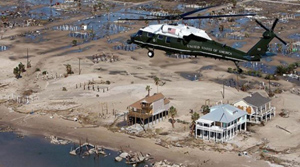
President George W. Bush touring Hurricane Ike’s destruction on the Bolivar Peninsula.
This was the first hurricane or tropical storm I experienced with my family in harm’s way. Nancy and I agreed we would stay home during Ike’s landfall. We shut down our campaign indefinitely. We made preparations for days without power at home. We explained to ten-year old Kate and seven-year old Grant what was coming our way. We prayed together to ease our fears. Kate went to bed with Nancy. Grant and I stayed up all night, ready to spring to action if a window was blown out or water was coming in our house. Just after 2 am, our power went out. Grant went to sleep on the couch while I sat beside him with a flashlight in hand. The sun finally came up. We were lucky. There had been a few minor leaks and a big chunk of our wooden fence was down. A cold front had come through, so not having air conditioning wasn’t a problem. We had a nice picnic in the backyard that evening.
Many of our neighbors were not so fortunate, especially those living on the water. They got overwhelmed with Ike’s 22 foot storm surge. Food, water, baby supplies, medicine, etc. were pouring into our region. The only way to get these items to our neighbors was raising an army of volunteers. So, this Sailor joined that Army.
The first full day of recovery operations, I drove to Pasadena, Deer Park, La Porte, Shore Acres, Clear Lake, Seabrook, Kemah, League City, Dickinson, Texas City, Hitchcock, Santa Fe, Alvin, Manvel, Pearland, Missouri City and Sugar Land. I was in full volunteer mode. The one thing I will always remember about those days is the love of others we Texans share. I would show up, ask how I can help and someone I had never met shook my hand, put their arm around me, thanked me and gave me a task. We came together for others in need. I had to smile when the Coast Guard Commander of our region told me the Battleship Texas had tried to do what all fighting ships do when docked in port for a storm – cast the lines off and get to the safety of open seas! As Ike’s storm surge grew, the Texas started floating out of her mud berth, with a heavy lift to port. If she broke away and sank, the Houston Ship Channel would be closed for years as 30,000 tons of steel, underwater, would need to be cut apart. To prevent a disaster, two tug boats crossed the ship channel, in the worst of Ike, to keep the Texas where she was. Texans being Texans.
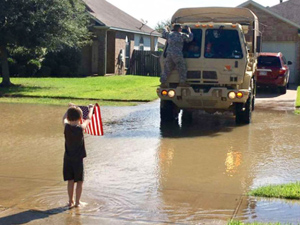
A young boy in Fort Bend saying “Thank you” to a National Guardsman.
Last, but certainly not least, was Hurricane Harvey. It initially plowed through Fort Bend County on August 17th, 2017. Harvey actually hit us twice. It was a slow mover, so the rain kept coming for days. At some spots, we experienced 50 inches of rain over two days. We learned our lessons from Ike and Rita – only three Fort Bend residents were killed in Hurricane Harvey. Just like Hurricane Ike, I spent the better part of August visiting and volunteering in Fort Bend and Brazoria counties. Once again, the generosity of ordinary Texans under crisis was unbelievable. And there was humor. The funniest story I heard was from a National Guardsman from the Midwest who left his family for 30 days to help us. As we were chatting, he mentioned he had done one of these deployments in the each of the last five years – hurricanes, tornadoes, wild fires and river floods. There are no days off when they are deployed. It’s 18 to 20 hour work days for 30 straight days. This hero was embarrassed. He confided that he normally lost ten to fifteen pounds on these deployments. He was embarrassed because he had gained ten pounds staying with us! He would wake up to the smell of free taquitos or kolaches. He did not know what this new breakfast food was, but he loved it! Lunch was Whataburger as far as the eye could see. Dinner? TexMex or massive steaks. He told me he had never been treated better on a deployment.
This photograph I found of a young boy in Fort Bend expressing his gratitude to a deployed Guardsman sums it up. During disaster, Fort Bend is Always Fort Bend Strong!
I am finishing up this column on September 1st, 2022. It will be published on October 1st. I pray that the 2022 hurricane season was quiet for us in September and continues until 2023. I welcome your input on my topic for the November 1st Fort Bend Strong. Right know, I am thinking about the Battleship Texas and its incredible, near perfect journey to Galveston in August. Of course, I may change my mind. There are no guarantees, except zero politics.
Natural disasters always make us Fort Bend Stronger!



 <
<







